The gradual loss of the police functions of the Peace Court: the creation of the police institution in Tandil 1872-1900
DOI:
https://doi.org/10.52885/2683-9164.v.n5.23251Keywords:
police, peace justice, State, societyAbstract
The great majority of the research on peace justice was mainly centred in the first half of the nineteenth century. Yet, in the state consolidation process, the decentralization of the functions of the peace justice was not given the same attention. We will analise the gradual loss of the coercive functions of the court of peace with the creation of the police station in Tandil in 1872, being the main commercial and service centre of the south of the Province of Buenos Aires. We will study not only the police crade with its functions and relation to the rest of the powers; but also its relation to the society which had called for its creation. Recovering these social actors as active individuals, we will see the participation they had in this process, how they experienced the topic of safety in a border society and their relation to the state. In this way, we will be able to incorporate the points of consensus with the civil society, together with vigilance and punishment.
Downloads
References
ÁLVAREZ Norberto y MÍGUEZ Eduardo, “Morir en la frontera. Patrones de mortalidad en las Tierras nuevas de la Provincia de Buenos Aires: Tandil (1860-1895)”, Siglo XIX, México, 1989.
BJERG María M, El mundo de Dorotea. La vida en un pueblo de la frontera de Buenos Aires en el siglo XIX, Buenos Aires, Imago Mundi, 2004.
BLACKWELDER Julia y JOHNSON Lyman, “Estadística criminal y acción policial en Buenos Aires, 1887-1914”, Desarrollo Económico, núm. 93, 1984.
BOTANA Natalio, El orden conservador, Buenos Aires, Sudamericana, 1977.
BOURDIEU Pierre, Esquisse d une theorie de la Pratique, precede de Trois Etudes d Ethnologie Kabyle, Genece, Droz, 1972.
CASANELLO Carlos, “Domiciliados y transeúntes en el proceso de formación estatal bonaerense (1820-1832)”, Entrepasados, núm. 6, 1994.
FOUCAULT Michel, Vigilar y Castigar. Nacimiento de la prisión, México, Siglo XIX, 1989.
FRADKIN Raúl, “Entre la ley y la práctica: La costumbre en la campaña bonaerense de la primera mitad del siglo XIX”, Anuario IEHS, núm. 12, 1997.
FRADKIN Raúl y PERRI Gladys, “Los vagos de la campaña bonaerense: la construcción histórica de una figura delictiva (1730-1830)”, Prohistoria, núm. 5, 2001.
FUGL Juan, Memorias de Juan Fugl. Vida de un pionero danés durante 30 años en Tandil-Argentina, 1844-1875, Traducidas por Alice LARSEN DE RABAL, Tandil, 1989.
GARAVAGIA Juan Carlo, “Ejército y milicia: Los campesinos bonaerenses y el peso de las exigencias militares 1810-1860”, Anuario IEHS, núm. 18, 2003.
GARAVAGLIA Juan Carlos, “Paz, orden y trabajo en la campaña: La justicia de Paz en Buenos Aires, 1830-1852”, Desarrollo Económico, núm. 37, 1997.
GAYOL Sandra, “Entre lo deseable y lo posible. Perfil de la policía de Buenos Aires en la segunda mitad del siglo XIX”, Estudios Sociales, núm. 10, 1996.
GAYOL Sandra, Sociabilidad en Buenos Aires. Hombres, Honor y Cafés, 1862-1910, Buenos Aires, Signo, 2000.
HALPERIN DONGHI, Una Nación para el desierto argentino, Buenos Aires, CEAL, 1982.
KETZELMAN Federico y DE SOUZA Rodolfo, Colección completa de leyes del estado y provincia de Buenos Aires desde 1854 a 1929, Buenos Aires, Lex, 1930.
LYNCH John, Masacre en las Pampas. La matanza de inmigrantes en Tandil, 1872, Buenos Aires, Emecé, 2001.
MÍGUEZ Eduardo, “La movilidad social de nativo e inmigrantes en la frontera bonaerense en el siglo XIX: datos, problemas, perspectivas”, Estudios Migratorios Latinoamericanos, núm. 24, 1993.
MÍGUEZ Eduardo, “Política, participación y poder. Los inmigrantes en las tierras nuevas de la provincia de Buenos Aires en la segunda mitad del siglo XIX”, Estudios Migratorios Latinoamericanos, año 2, núm. 6-7, 1987.
NARIO Hugo, Tata Dios. El Mesías de la última montonera, Buenos Aires, Plus Ultra, 1976.
OSZLAK Oscar, La formación del Estado argentino, Buenos Aires, Belgrano, 1982.
PALACIO Juan Manuel, La paz del trigo. Cultura legal y sociedad local en el desarrollo agropecuario pampeano (1890-1945), Buenos Aires, Edhasa, 2004.
RUIBAL Beatriz, “El control social y la policía de Buenos Aires 1880-1920”, Boletín del Instituto de Historia Argentina y Americana “Dr. Emilio Ravignani”, tercera serie, núm. 2.
RUIBAL Beatriz, Ideología del control social, Buenos Aires, 1880, 1920, Buenos Aires, CEAL, 1993.
SALVATORE Ricardo, “Reclutamiento militar, disciplinamiento y proletarización en la era de Rosas”. Boletín del Instituto de Historia Argentina y Americana “Dr. Emilio Ravignani”, tercera serie, núm. 21, 2000.
SUÁREZ MARTÍNEZ Manuel, Paladín del orden y gestor del progreso del Partido de Lobería. Apuntes Autobiográficos de 1845 a 1880, Tandil, 1993.
Downloads
Published
Issue
Section
License
Aquellos autores/as que tengan publicaciones con esta revista, aceptan los términos siguientes:
- Los autores/as conservarán sus derechos de autor y garantizarán a la revista el derecho de primera publicación de su obra, el cuál estará simultáneamente sujeto a una Licencia de reconocimiento de Creative Commons. Se puede compartir, copiar, distribuir, ejecutar y comunicar públicamente la obra, siempre que: a) se cite la autoría y la fuente original de su publicación (revista, editorial y URL de la obra); b) no se use para fines comerciales; c) no se altere, transforme o genere una obra derivada a partir de esta obra.
- Los autores/as podrán adoptar otros acuerdos de licencia no exclusiva de distribución de la versión de la obra publicada (p. ej.: depositarla en un archivo telemático institucional o publicarla en un volumen monográfico) siempre que se indique la publicación inicial en esta revista.
- Se permite y recomienda a los autores/as difundir su obra a través de Internet (p. ej.: en archivos telemáticos institucionales o en su página web) después del proceso de publicación, lo cual puede producir intercambios interesantes y aumentar las citas de la obra publicada. (Véase El efecto del acceso abierto).









